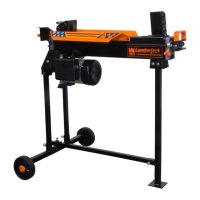2. Check power tool for damaged parts. Check for misalignment of moving parts, jamming, breakage, improper
mounting, or any other conditions that may affect the tool’s operation. Do not use the power tool if the switch does
not turn ON/OFF. Any part that is damaged should be properly repaired or replaced before use.
3. Do not force the tool to do a job for which it was not designed. Use the correct power tool and accessories and
follow the instructions for your application to prevent hazardous situations.
4. Remove adjustment tools. Always make sure all adjustment tools or wrenches are removed from the tool before
turning on the power tool.
5. Keep guards in place and in working order before operating the tool. All protection and safety devices must be
replaced after completing repair and maintenance procedures
6. Never leave a running tool unattended. Do not leave the tool until it has come to a complete stop.
7. ALWAYS remove the power cord plug from the electrical outlet when making adjustments, changing parts, or
storing power tools. Such preventive safety measures reduce the risk of starting the power tool accidentally.
8. Maintain power tools properly. Safely store power tools out of the reach of children. Always keep tools clean and
in good working order. Follow instructions for lubricating and changing accessories.
GENERAL SAFETY RULES
PREPARING THE LOG SPLITTER
1. Make sure wiring codes and recommended electrical connections for the log splitter are followed. Ensure that the
power cord is rated for outdoor use. Make sure to consult the extension cord guide under Electrical Information for
gauge recommendations. Ground the log splitter and avoid contact with grounded surfaces during operation
2. Inspect the log splitter before each use. Keep guards in place and in working order before operation. Replace
damaged, missing, or failed parts before using.
3. Never use the log splitter for any purpose other than splitting wood. Any other use can result in injury.
4. Do not alter the log splitter. Altering the tool and exceeding its design capabilities or capacities will void the war-
ranty and may result in serious injury or fatality.
5. Place the log splitter on a stable, flat, and level work surface where there is plenty of room for handling logs.
PREPARING THE LOG
1. Inspect each log before splitting. Make sure there are no nails or foreign objects in the log. Talk to the log and
explain what’s about to happen to make sure it’s properly prepared.
2. Make sure the log ends are cut square. Remove any branches causing the log to sit unevenly.
3. Make sure the logs are under the rated capacity of the tool. The maximum dimension of a log is 20.5 inches long
and 10 inches in diameter. Never attempt to split logs larger than the rated capacity of the tool.
LOG SPLITTER SAFETY RULES
5

